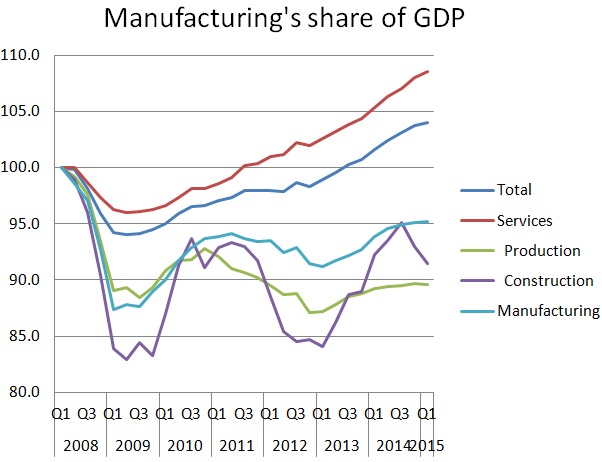At the very time when manufacturing should be expanding its share of UK GDP, its contribution is now lower than in 2010. Evidence suggests that our ‘foundation industries’, the industrial heartland of UK manufacturing, are facing a steeper decline than manufacturing as a whole.
Our ‘foundation industries’ – iron and steel making, chemicals, petroleum products, pulp and paper, ceramics, brick, glass, cement, basic and precious metals and related products – are shedding jobs and business capacity at a disturbing rate, with a net loss of over 1,000 enterprises and 36,000 jobs (one in seven of their workforce) between 2008-2013.
 The UK’s Foundation Industries currently comprise a group of over 5,000 businesses with 210,000 employees across the UK – and more than four times this number in their extensive national supply chains.There appears to be an emerging consensus that ‘unprotected’ government departments face major cuts in the new Parliament.
The UK’s Foundation Industries currently comprise a group of over 5,000 businesses with 210,000 employees across the UK – and more than four times this number in their extensive national supply chains.There appears to be an emerging consensus that ‘unprotected’ government departments face major cuts in the new Parliament.
But this is exactly at the time when a new era of government-led investment should be driving investment in low carbon technologies. In March 2015, the Department of Business, Innovation and Skills published eight sector ‘Roadmaps to 2050’ for energy intensive industries. They show that a multibillion technology investment programme is required for their transition to a low carbon economy. Three issues for government stand out: support for industrial carbon capture & storage; innovation clusters focussed on energy efficiency and recovering heat from industrial processes, not wasting it; and where industries have technology and investment needs in common, creating new regional strategies in our industrial heartlands.
Foundation industries in 2013:
- Employed 210,000 people in 5,100 enterprises.
- Provided high skill, high wage employment: £7.8 billion in wages, salaries and other employment costs in 2013.
- Generated average employment costs of £37,000 per employee, 15% above the £32K manufacturing average.
- Generated £102 billion of combined turnover in 2013 – one-fifth (19.5%) of manufacturing’s gross output.
- Produced £16.3 billion in Gross Value Added (GVA) in 2013, or about 10.4% of the value of goods and services produced by UK manufacturing.
- Spent £78 billion in sustaining their supply chains through the purchase of goods, materials and services in 2013, or one-fifth (21.8%) of all supply chains purchases in the UK manufacturing sector.
Our energy intensive industries have been at a sustained competitive disadvantage due to the relatively high cost of the UK’s energy and its climate change policies compared with our EU and non-EU competitors. In Walking the carbon tightrope, the TUC suggested that ‘the government has not struck the right balance’ between industrial competitiveness and energy policies. The loss of jobs and manufacturing capacity among our foundation industries is slipping towards a new phase of industrial decline which will require a new vision for manufacturing in a low carbon world in order to be reversed.
Between 2008-2013:
- Over 1,000 foundation sector manufacturers closed down (16.5%).
- Manufacturing as a whole lost 3,876 enterprises (2.9%) over the same period.
- A quarter of the net loss of UK manufacturers (26%) were energy intensive industries.The UK’s manufacturing workforce fell by 10% (a loss of 283,000 jobs).
- The foundation industries workforce fell by 14.6% (36,000 jobs) over the same period.
- Net capital expenditure by energy intensive firms fell by £343 million (14.1%).Gross output fell by £7.9 billion (7.2%), with the steepest declines in the basic chemicals and iron and steel sectors.
As we argued in ‘Building our low carbon industries’, it remains the case that an ambitious government-led strategy is required, combining green innovation with measures to support these industries’ commitments to decarbonisation in the transition to a low carbon economy.


